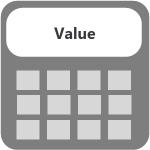
Process Variable Surveillance is a complex process capable of concurrently monitoring multiple conditions such as transgression of limits, state duration, and movement between states. It compares process variable data against defined limits and conditions.
Read more

Performance Curve is a complex process capable of concurrently monitoring multiple conditions such as transgression of limits, state duration, and movement between states. The Performance Curve process compares process variable data against limits and conditions that are defined by a performance curve. It uses a polynomial equation with coefficient and constant values from either fixed values or entities, or a combination of both.
Read more

The Min Max process is used for testing continuous data for a monitor item. The sample data is tested against a maximum limit (Max) and a minimum limit (Min). The process can be specified to test against both Min and Max limits, just against a Max limit, or just against a Min limit.
Read more

The Logic process independently evaluates up to four different inputs, each with its own limits and offsets. The different states (state 1 up to state 8), are determined based on the application of various logic rules that use one or more of the input evaluation outcomes as their operands.
Read more

The Drift Detection Process monitors the deviation between process variable data (inputs) and a reference input. The reference input can either be a fixed value, or it can be a dynamic value such as an entity.
Read more

The Discrete Min Max process is used for testing discrete data for a monitor item. The sample data is tested against a maximum limit, Max, and a minimum limit, Min. The process can be specified to test against Max and Min limits, just against a Max limit, or just against a Min limit. Any periods where no data is found will cause a No Data event.
Read more

The Digital State process is for evaluating different state pairs of the monitor item. The monitor item that is being tested will be in either one of two states. If it is in a Default Entity state, a default state is maintained. If it is in a Primary Limit Entity state, a primary state is reached.
Read more

The Alarm process is used for testing continuous data for a monitor item. The sample data is tested against high limits (High and High High), and against low limits (Low and Low Low).
Read more

Returns the value of an item as a single value variable from the given collection variable.
Read more

This pages lists the IFS OI Field Operator: Explorer Edition release notes available in the Help Center.
Read more



